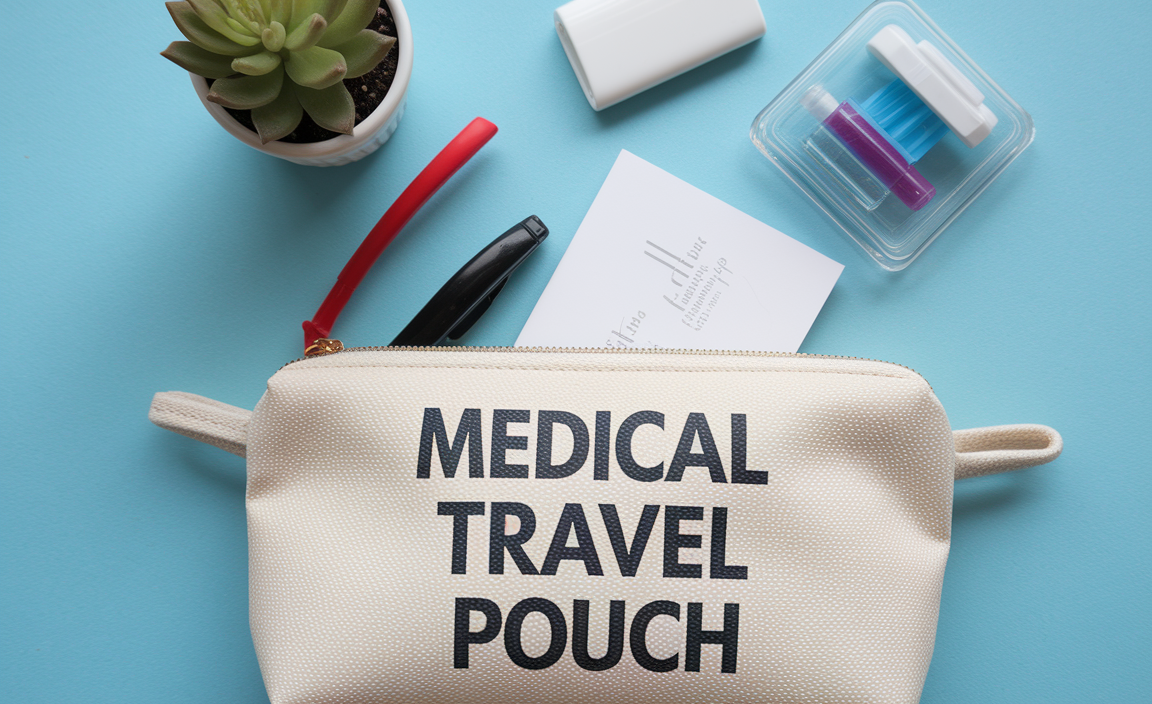Reusable adult diapers offer a comfortable, eco-friendly, and cost-effective alternative to disposables. They provide reliable protection for various needs, ensuring confidence and freedom for travel and daily life. Learn how to choose, use, and care for them to maximize comfort and convenience.
Dealing with incontinence can feel like a hurdle, especially when you’re planning a trip or just navigating daily life. You might be looking for solutions that are kinder to the planet and your wallet, while still giving you that essential peace of mind. If you’ve been curious about reusable adult diapers, you’re in the right place! They’re a fantastic option for many, offering comfort, security, and a way to reduce waste. We’ll break down everything you need to know, from choosing the right type to keeping them clean and ready for your next adventure. Get ready to discover a practical and comfortable solution that empowers you to live life to the fullest.
Why Choose Reusable Adult Diapers?
Reusable adult diapers, also known as cloth adult diapers or washable incontinence briefs, are gaining popularity for good reason. They offer a compelling blend of benefits that make them a practical choice for many individuals. Beyond just comfort, they represent a significant shift towards sustainable and economical personal care. Let’s explore some of the key advantages:
Environmental Friendliness
One of the most significant draws of reusable adult diapers is their positive impact on the environment. Traditional disposable diapers contribute substantially to landfill waste. According to the U.S. Environmental Protection Agency, disposable diapers are a notable component of municipal solid waste. By choosing reusable options, you drastically reduce your personal contribution to this growing problem. Each reusable diaper can replace hundreds or even thousands of single-use disposables over its lifespan, meaning less plastic, less manufacturing impact, and a greener footprint for your routine.
Cost-Effectiveness
While the initial investment in a set of reusable adult diapers might seem higher than a single pack of disposables, the long-term savings are substantial. Once you have a collection of reusable diapers (typically 6-12 depending on washing frequency), you essentially eliminate the ongoing cost of purchasing disposable products. This can add up to significant savings over months and years, freeing up budget for other essentials or enjoyable experiences. It’s an investment that pays for itself quickly.
Comfort and Breathability
Many people find reusable adult diapers to be more comfortable than disposables. Often made from soft, breathable fabrics like cotton or bamboo blends, they can be gentler on the skin. This breathability helps to reduce moisture buildup, which can lead to irritation and discomfort. The fabric also tends to feel less bulky and “plastic-y” than many disposable options, allowing for a more natural feel and better freedom of movement. This is particularly beneficial for those who are managing incontinence long-term or spend extended periods wearing protection.
Skin Health
The natural, breathable materials used in many reusable diapers can contribute to better skin health. By allowing air to circulate, these diapers help prevent the trapped moisture that can lead to rashes and irritation. Some brands are also free from the chemicals, fragrances, and dyes often found in disposable products, further reducing the risk of allergic reactions or sensitivities. For individuals with sensitive skin or a history of skin breakdown, this can be a game-changer.
Customizable Fit and Absorbency
Reusable adult diapers come in various designs, including all-in-one styles, pocket diapers (where an absorbent insert is placed inside a waterproof cover), and modular systems. This variety allows for a more customizable fit, ensuring better leak protection and comfort tailored to your body shape. Many also offer adjustable absorbency. You can add extra inserts or boosters for increased protection during long journeys, overnight use, or times of higher need, giving you control over your level of security.
Types of Reusable Adult Diapers
Navigating the world of reusable adult diapers can seem a little daunting at first, but understanding the different types available will help you find the perfect fit for your needs. The primary distinctions lie in their construction and how absorbency is managed. Here’s a breakdown of the most common types:
All-in-One (AIO) Diapers
As the name suggests, AIO diapers are designed for maximum simplicity. They have the absorbent layers permanently attached to a waterproof outer shell. Think of them like a regular diaper, but washable. They are the easiest to use, making them a popular choice for caregivers and individuals looking for a straightforward option similar to disposables. They often feature leg cuffs and a waist closure (like hook-and-loop or snaps) for a secure fit.
Pocket Diapers
Pocket diapers consist of a waterproof outer cover and an inner absorbent lining. Crucially, there’s an opening or “pocket” between the lining and the cover. This pocket is where you insert the absorbent boosters or inserts. The advantage here is that you can customize the absorbency by adding more or different types of inserts for your specific needs. Pocket diapers are also great because the inserts can be removed before washing, allowing for faster drying times compared to AIOs.
Diaper Covers with Inserts
This system involves a separate waterproof diaper cover and absorbent inserts. The inserts (which can be made of various materials like pre-fold cloth, contoured pads, or other absorbent fabrics) are placed inside the cover. The cover is then secured around the body. This system is often the most versatile and can be very cost-effective. You can mix and match covers and inserts, and it allows for easy adjustment of absorbency. Many people also find this system allows for better airflow and a less bulky feel than AIOs.
All-in-Two (AI2) Systems
AI2 systems are similar to diaper covers with inserts but are often designed to snap or attach together in a specific way. The absorbent inserts usually have snaps or a special design that allows them to attach securely to the waterproof cover, preventing shifting. The benefit is that if the insert is not heavily soiled, you might be able to reuse the waterproof cover for the next change, which can save on washing. However, for adult incontinence, it’s generally recommended to change both the insert and the cover if they are soiled for optimal hygiene.
Absorbent Materials and Inserts Explained
The absorbency of any reusable diaper system relies heavily on the inserts or the internal padding. Common materials include:
- Cotton: Natural, soft, and highly absorbent, though it can take longer to dry.
- Bamboo: Often blended with cotton, bamboo is known for its softness, natural antibacterial properties, and good absorbency. It’s also quite breathable.
- Hemp: More absorbent than cotton and very durable, hemp is a strong, sustainable fiber. It can feel a bit stiffer initially but softens with washing.
- Microfiber: A synthetic material that is very absorbent and dries quickly. It’s often used in pocket diaper inserts.
- Charcoal Bamboo: A blend that often uses charcoal-infused fibers on the surface to help wick moisture away from the skin, giving a drier feel.
You can often purchase inserts separately to add to your chosen diaper system, allowing you to tailor the absorbency level precisely to your comfort and security needs.
Choosing the Right Reusable Adult Diaper
Selecting the perfect reusable adult diaper involves considering a few key factors. It’s not a one-size-fits-all situation, and what works for one person might not be ideal for another. Think about your lifestyle, the level of protection you need, and what feels most comfortable against your skin. Here’s a guide to help you make an informed decision:
Consider Your Absorbency Needs
This is the most critical factor. Are you dealing with light leakage, moderate needs, or heavy incontinence? Different diapers and insert combinations offer varying levels of absorbency. For light needs, a thinner insert within a cover might suffice. For moderate to heavy incontinence, you’ll want diapers with built-in absorbency or systems that allow for multiple, thick inserts, potentially including overnight boosters. Brands often provide absorbency ratings, so look for those that match your requirements. Understanding the National Institute of Diabetes and Digestive and Kidney Diseases information can help you better understand incontinence types and management strategies.
Understand Sizing and Fit
Just like any garment, reusable adult diapers come in different sizes. It’s crucial to measure your waist and hips accurately according to the manufacturer’s sizing chart. A proper fit is essential for preventing leaks and ensuring comfort. Too tight, and it can be uncomfortable and dig into your skin. Too loose, and you risk leaks. Look for features like adjustable waistbands, flexible leg elastics, and secure fastenings (snaps or hook-and-loop) that allow you to customize the fit.
Evaluate Materials for Comfort and Sensitivity
If you have sensitive skin, pay close attention to the materials used. Outer covers are typically made from PUL (polyurethane laminate), which is waterproof yet breathable. The inner lining that contacts your skin can be microfiber, cotton, bamboo, or stay-dry fabrics. Microfiber can feel dry to the touch but might not be ideal for very sensitive skin. Cotton and bamboo are soft and natural. Some diapers have a “stay-dry” layer (often polyester) that wicks moisture away from the skin to a more absorbent layer underneath, keeping you feeling drier. Consider what feels best against your skin and is least likely to cause irritation.
Look at Fastening Styles
Reusable adult diapers come with different ways to secure them:
- Snaps: Often considered more durable and can provide a very secure fit. They can take a bit more practice to master but are excellent for preventing accidental unsnapping.
- Hook-and-Loop (Velcro-style): These are easy to adjust and re-fasten, similar to disposable diapers. However, they can wear out over time and may catch on laundry if not secured properly during washing.
- Pull-on Styles: Some reusable diapers are designed like underwear, with elastic waistbands and leg cuffs, offering a discreet look and feel. These are generally best for those with lighter needs or who can manage to pull them up and down independently.
Consider Ease of Cleaning
While washable, properly cleaning reusable diapers is important for hygiene and longevity. Most can be washed in a washing machine with regular detergent, but some manufacturers recommend specific washing routines (e.g., cold rinse, hot wash, extra rinse, air dry). Check the care instructions for the specific products you’re considering. Pocket diapers with removable inserts tend to dry faster than AIOs.
Read Reviews and Seek Recommendations
Don’t underestimate the power of other users’ experiences! Read reviews online to see what people are saying about different brands and styles. Look for feedback on durability, leak protection, comfort, and ease of use. Online communities and forums dedicated to cloth diapering or incontinence solutions can also be valuable resources for recommendations and advice.
How to Prepare and Use Reusable Adult Diapers
Getting started with reusable adult diapers is simpler than you might think. The key is proper preparation before use and a straightforward approach to changing and maintenance. Here’s a step-by-step guide to ensure you’re comfortable and confident.
Step 1: Prep Your Diapers
Before their first use, and periodically after that, it’s essential to “prep” your reusable diapers. This usually involves a series of washes to:
- Remove Manufacturing Residues: Many new cloth products have residues from the manufacturing process that can affect absorbency.
- Increase Absorbency: Natural fibers like cotton, bamboo, and hemp become more absorbent after several washes.
- Sanitize: Ensure they are thoroughly clean and hygienic.
Follow the manufacturer’s specific instructions for initial prep, which often involves washing them 3-5 times with a small amount of detergent and without fabric softener, alternating between hot and warm washes as recommended. Air drying between washes can also help.
Step 2: Apply the Diaper
The application will vary slightly depending on the type of diaper you’ve chosen (AIO, pocket, cover with inserts).
- For AIOs: Unfold the diaper. Place it between your legs, ensuring the waterproof outer layer is on the outside. Bring the front panel up between your legs and secure the side tabs to the front panel, adjusting for a snug but comfortable fit around your waist. Ensure leg cuffs are lying flat against your skin for a good seal.
- For Pocket Diapers: First, stuff the absorbent insert(s) into the pocket. Then, apply the diaper as you would an AIO, bringing the front and back panels together and securing the side tabs.
- For Diaper Covers with Inserts: Place the insert against the inside of the cover or position it as directed by the manufacturer. Then, put on the cover and secure it around your waist and legs, similar to an AIO.
Make sure the diaper fits snugly around the legs and waist without being uncomfortably tight. You should be able to fit a finger comfortably inside the waistband.
Step 3: Checking and Changing
Check the diaper periodically, especially if you are new to it, to get a feel for when it needs changing. For changes:
- Unfasten the diaper completely.
- If soiled with feces, remove excess with a wipe or gently scrape into the toilet before placing the diaper in a wet bag or pail.
- For heavy soiling, it’s often best to rinse the diaper in the toilet before storing it for washing.
- Clean yourself thoroughly with wipes or by showering.
- Apply a fresh, clean diaper.
Step 4: Storage for Washing
Contaminated diapers should be stored in a dry place until you have enough for a full wash load, typically every 1-2 days. A waterproof wet bag or a pail with a lid can be used. Avoid leaving soiled diapers in a sealed pail for too long, as this can promote ammonia buildup and stains. Some people prefer to rinse heavily soiled diapers in cold water before storing them to help manage odors and stains.
Step 5: Washing Your Reusable Diapers Properly
Proper washing is crucial for hygiene, odor control, and the longevity of your diapers. While specific instructions vary by brand, a common and effective washing routine is:
- Pre-Rinse: Run a cold water rinse cycle to remove any remaining urine or loose solids.
- Main Wash: Use a hot water cycle (around 120°F / 50°C or higher) with a small amount of a good quality, preferably free-and-clear detergent. Avoid using too much detergent, as it can lead to buildup and affect absorbency, and avoid fabric softeners, which can coat the fibers and reduce absorbency.
- Extra Rinse: If your machine has an option, an extra rinse cycle is highly recommended to ensure all detergent is removed. This is particularly important for preventing rashes.
- Drying:
- Machine Drying: Use a medium heat setting. High heat can damage the waterproof lining (PUL) over time.
- Line Drying: If possible, line drying in the sun is excellent for natural disinfection and stain removal for white or light-colored diapers.
Important Notes on Washing:
- Wash a full load of cloth diapers to ensure they agitate properly and rinse well. If you don’t have enough for a full load, you can add small items like washcloths or burp cloths.
- Avoid washing them with delicate clothes or items that shed a lot of lint.
- Strip washing (a deep cleaning process) might be needed periodically to remove stubborn buildup or odors.
- For more detailed washing advice, consult resources like Padded Tush Stats, which offers extensive cloth diaper washing guides and







